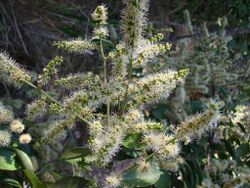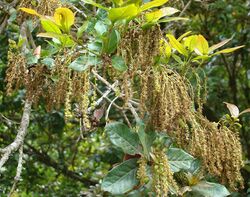Biology:Licania
| Licania | |
|---|---|

| |
| Licania humilis | |

| |
| Licania arborea | |
| Scientific classification | |
| Kingdom: | Plantae |
| Clade: | Tracheophytes |
| Clade: | Angiosperms |
| Clade: | Eudicots |
| Clade: | Rosids |
| Order: | Malpighiales |
| Family: | Chrysobalanaceae |
| Genus: | Licania Aubl.[1] |
| Diversity | |
| About 220 species | |
Licania is a genus of over 200 species of trees and shrubs in the family Chrysobalanaceae.[2] Species are found naturally occurring in Neotropical forests from southern Mexico to Brazil and the Lesser Antilles. Due to increased deforestation and loss of habitat, several species have declined, some markedly so, and L. caldasiana from Colombia appears to have gone extinct in recent years.[3] Many species are either rare or restricted in distribution and therefore potentially threatened with future extinction.
Several species are used as ornamental plants. Licania fruit are important food for many animals and can also be eaten by humans. Caterpillars of a possible new taxon of the Astraptes fulgerator cryptic species complex were found on L. arborea but do not seem to eat them regularly.[4][5] Like other members of its family, the genus is known for producing a diverse array of flavonoid compounds.[6][7][8]
Selected species
Species include:[9]
- Licania arborea
- Licania caldasiana
- Licania chiriquiensis
- Licania conferruminata
- Licania fasciculata
- Licania grandibracteata
- Licania hedbergii
- Licania humilis
- Licania kunthiana
- Licania longicuspidata
- Licania longipetala
- Licania megalophylla
- Licania michauxii – Gopher apple, ground oak
- Licania morii
- Licania platypus – Sansapote
- Licania pyrifolia – Merecure
- Licania rigida – oiticica (Brazil)
- Licania salicifolia
- Licania splendens
- Licania tomentosa – oitizeiro (Brazil)
- Licania vasquezii
- Licania velutina
References
- ↑ "Licania". World Checklist of Selected Plant Families. Royal Botanic Gardens, Kew. http://apps.kew.org/wcsp/namedetail.do?name_id=352408.
- ↑ "Licania Aubl. | Plants of the World Online | Kew Science". http://powo.science.kew.org/taxon/urn:lsid:ipni.org:names:30167386-2.
- ↑ Lopez-Gallego, C.; Morales M, P. (2020). "Licania caldasiana". IUCN Red List of Threatened Species 2020: e.T32074A182978362. doi:10.2305/IUCN.UK.2020-3.RLTS.T32074A182978362.es. https://www.iucnredlist.org/species/32074/182978362. Retrieved 17 November 2021.{{cite iucn}}: error: malformed |doi= identifier (help)
- ↑ Paul D. N. Hebert; Erin H. Penton; John M. Burns; Daniel H. Janzen; Winnie Hallwachs (2004). "Ten species in one: DNA barcoding reveals cryptic species in the neotropical skipper butterfly Astraptes fulgerator". Proceedings of the National Academy of Sciences 101 (41): 14812–14817. doi:10.1073/pnas.0406166101. PMID 15465915. PMC 522015. Bibcode: 2004PNAS..10114812H. http://www.pnas.org/cgi/reprint/101/41/14812.pdf.
- ↑ Andrew V. Z. Brower (2006). "Problems with DNA barcodes for species delimitation: 'ten species' of Astraptes fulgerator reassessed (Lepidoptera: Hesperiidae)". Systematics and Biodiversity 4 (2): 127–132. doi:10.1017/S147720000500191X. http://www.bolinfonet.org/pdf/Brower_2006SYSTBIODIVERSITY%5B1%5D.pdf.
- ↑ Bilia, Anna Rita; Ciampi, Lucia; Mendez, Jeannette; Morelli, Ivano (August 1996). "Phytochemical investigations of Licania genus. Flavonoids from Licania pyrifolia". Pharmaceutica Acta Helvetiae 71 (3): 199–204. doi:10.1016/0031-6865(96)00009-x. ISSN 0031-6865.
- ↑ Mendez, Jeannette; Bilia, Anna Rita; Morelli, Ivano (September 1995). "Phytochemical investigations of Licania genus. Flavonoids and triterpenoids from Licania pittieri". Pharmaceutica Acta Helvetiae 70 (3): 223–226. doi:10.1016/0031-6865(95)00027-7. ISSN 0031-6865.
- ↑ Bilia, Anna Rita; Mendez, Jeannette; Morelli, Ivano (August 1996). "Phytochemical investigations of Licania genus. Flavonoids and triterpenoids from Licania carii". Pharmaceutica Acta Helvetiae 71 (3): 191–197. doi:10.1016/0031-6865(96)00010-6. ISSN 0031-6865.
- ↑ "search for Licania". The Plant List. http://www.theplantlist.org/tpl1.1/search?q=Licania.
External links
Wikidata ☰ Q135759 entry
 |

